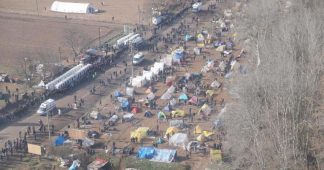By
March 19, 2020
The governor’s office in Turkey’s western border province of Edirne announced March 17 that 147,132 migrants had crossed into EU territory from the province since Feb. 28, when Ankara said it would no longer stop refugees from moving on to Europe. The statement might have been passed over as routine were it not an implicit declaration that Turkey’s “operation” of sending refugees to Europe via Greece had tacitly come to an end.
President Recep Tayyip Erdogan had confirmed Feb. 29 that the operation was underway, saying, “We had said months ago that we would be forced to open the gates if it went on like this. They didn’t believe us. And what did we do yesterday? We did open the gates. The number [of migrants crossing the border] has reached 18,000 as of this morning.” Stressing his resolve, he added, “We will keep the gates open in the coming period and this will continue.”
On the morning of Feb. 28, free buses, hired by unknown organizers, began ferrying hundreds of refugees from Istanbul to the Greek border. Scenes of frantic refugees elbowing their way into the coaches, lined on a spacious avenue across the Istanbul Police Directorate in the center of the city, were broadcast live on scores of TV channels, which were evidently notified in advance of what was going to happen.
In the border region, Turkish security forces took measures to facilitate the migrants’ passage to Greece, while their Greek counterparts sprung into heavy-handed action to stop the influx. The face-off continued for days.
And why does the March 17 statement of the Edirne governor’s office, which claimed that more than 147,000 refugees had crossed the border, amount to an acknowledgement that the operation has come to a de facto end? To answer this question, one needs to go back to March 1 and review how the process unfolded thereafter.
On March 1, Turkish Interior Minister Suleyman Soylu tweeted, “The number of migrants who have left our country via Edirne has reached 100,577 as of 7:40 p.m.” This was the first in a series of daily tweets, in which Soylu let his followers know how many migrants had “left” Turkey from Edirne. The minister’s counter hit 130,469 on March 3 and 135,844 the following day. That Soylu was able to provide precise figures on a daily basis amounted to an implicit acknowledgement that the tumult on the border unfolded within the knowledge and under the control of the Turkish state.
The minister’s last tweet on the issue put the figure at 142,175 on March 6. Given the March 17 tally of the Edirne governor’s office, this means that only about 5,000 people “crossed” to Greece in the 11 days after March 6. The relatively small difference suggests that the alleged influx of migrants into Greece has significantly slowed or almost ground to a halt.
From the very outset, Greece disputed Turkey’s tally of “migrants crossing the border,” calling the numbers “entirely false and misleading.” On March 1, hours before Soylu put the figure at 100,577, the Greek Foreign Ministry slammed Ankara for waging a “disinformation campaign.” In a statement on Twitter, the ministry said that 10,000 people had been prevented from entering Greek territory over the past 24 hours and that 73 people — unrelated to the Syrian province of Idlib, where fighting had escalated at the time — managed to cross illegally before being arrested.
Judging by the events on the ground, it is not hard to conclude that Turkey had long made preparations for an “operation” to send off refugees to Europe via Greece, with contingency plans already in place. The migrants’ movement to the border could have hardly reached such proportions at the outset unless an efficient state capacity was at work in terms of organization, coordination and communication. The tough attitude the Greek side adopted as soon as the refugees showed up at the border was similarly a sign that plans were in place for a heavy-handed response to stop a possible influx.
Greece was not caught off guard because Erdogan had repeatedly threatened to “open the gates.” In an Oct. 24 speech, for instance, he said: “They grow anxious each time I say we could open the gates. Don’t be anxious — the gates will be opened when the time comes. Let’s see how you accommodate hundreds of thousands as we do. You have money and power. You phone us when 100 people cross to Greece, but we have 4 million people here.”
So, what was the main factor that made Feb. 28 the right moment for Erdogan to “open the gates”? Was it some fresh disappointment in Turkey’s ties with the EU? No, the triggering development had no direct link to Turkish-EU relations. Erdogan decided to “open the gates” right after 36 Turkish soldiers were killed Feb. 27 in a Russian-Syrian airstrike in Idlib. Hence, Ankara’s launch of the refugee operation Feb. 28 aimed to assuage public indignation over the death toll in Idlib, the worst the Turkish army has suffered in a single attack since the 1974 Cyprus war, and to distract the public and change or suppress the news agenda.
Public discontent was already on the rise over the 3.5 million Syrians taking shelter in Turkey, marked by growing tensions between refugees and local communities. The crisis was seen as among the factors behind the losses that the ruling Justice and Development Party suffered in the local elections last year.
In the face of the heavy loss in Idlib, Ankara wanted the public to take solace in thinking that Turkey was at least getting rid of the Syrians. Hence, Soylu’s daily counter was aimed at showing and impressing the public that the Syrians were finally leaving the country.
Back in 2015, 1.1 million refugees, most of them Syrians, had flowed to Europe from Turkey in another episode of “open gates.” Yet no Turkish official offered daily updates on how many refugees had crossed to EU territory, for the flow at the time was truly aimed at the EU and not the Turkish public.
Unlike the exodus in 2015, Ankara spared Bulgaria, Turkey’s second EU neighbor, this time, steering the refugees only to Greece. Bulgaria’s favorable treatment might have owed to the visit of its prime minister to Ankara March 2, but one cannot overlook that Bulgaria is the key route of land transport from Turkey to Europe. In other words, Bulgaria had its own trump cards against Turkey.
Ankara’s refugee operation was so in sync with the war in Idlib that the date of Soylu’s last tweet on the number of migrants crossing to Greece — March 6 — could have hardly been incidental either. The day before, Turkey and Russia had agreed on a cease-fire in Idlib. The ensuing de-escalation in Idlib was mirrored by easing tensions at the Turkish-Greek border. In a further move defusing the tensions, the Turkish coast guard announced March 7 it would no longer let refugees sail to Greek islands from Turkey’s Aegean coast, citing instructions by Erdogan.
The “refugee crisis” that Ankara ignited Feb. 28 was intended as a dual-use instrument. Its first and foremost purpose was to suppress the Idlib agenda and alleviate the “Syrian refugee crisis” in the public’s perception. Taking advantage of the situation, Ankara sought to also put pressure on the EU, as evidenced by the words of Foreign Minister Mevlut Cavusoglu, who spoke of the need to update the refugee accord between Turkey and the EU, which was signed in 2016 but has not been fully implemented.
Ankara may have partially succeeded in using the new “refugee crisis” to overshadow its losses in Idlib, but the crisis did nothing to alleviate Turkey’s Syrian refugee burden. This is because Syrians made up only a small minority among the migrants who flocked or were bussed to the Greek border. Journalists who covered the events on the ground told Al-Monitor that Afghans were the largest group among the migrants, followed by Iranians, Pakistanis and Iraqis.
In contrast, the migrants who flowed to Europe in 2015, when Turkey loosened border controls quietly, were overwhelmingly Syrian. What changed in five years that the Syrians were reluctant to leave this time?
The answer is that the Syrians have largely settled down in Turkey, making a life for themselves, for better or worse. The statistics show that the number of Syrians in Turkey has stabilized at 3.5 million since 2017. So, when they have the chance to decide for themselves, they seem to prefer staying in Turkey instead of braving new ventures in Europe. And in the face of an unwelcoming Europe, as seen at the Greek border, they would hardly run the risk of pushing the limits.
The refugee crisis that Ankara instigated Feb. 28 at the Greek border has shed light on two important realities. First, the Syrians are unlikely to leave Turkey willingly unless the West promises them a better life. Consequently, any threats to unleash hundreds of thousands of Syrians on Europe will no longer have the same effect after the latest crisis.
Second, a vigilant Greece enforced tough measures at the border, preventing Ankara from effectively using its refugee card. By attempting to use the refugee card again, Ankara, in fact, helped others to see that that card has expired.
Published at https://www.al-monitor.com/pulse/originals/2020/03/turkey-syria-europe-why-refugee-card-lost-its-impact.html











